Organisational Behaviour Analysis: A David & Co. Ltd Report
VerifiedAdded on 2020/12/09
|13
|4239
|417
Report
AI Summary
This report provides an analysis of organisational behaviour within A David & Co. Ltd, a food and beverage manufacturing company. It delves into the influence of organizational culture, politics, and power on individual and team performance, examining how Handy's culture is implemented. The report evaluates content and process theories of motivation, specifically Maslow's Hierarchy of Needs and Expectancy Theory, and assesses effective versus ineffective team dynamics. It highlights the positive and negative impacts of organizational culture and politics, as well as the role of power in the workplace. The report also explores Hofstede's model for improving cross-cultural communication. The report concludes by demonstrating how understanding organizational behavior concepts and philosophies contribute to organizational effectiveness.
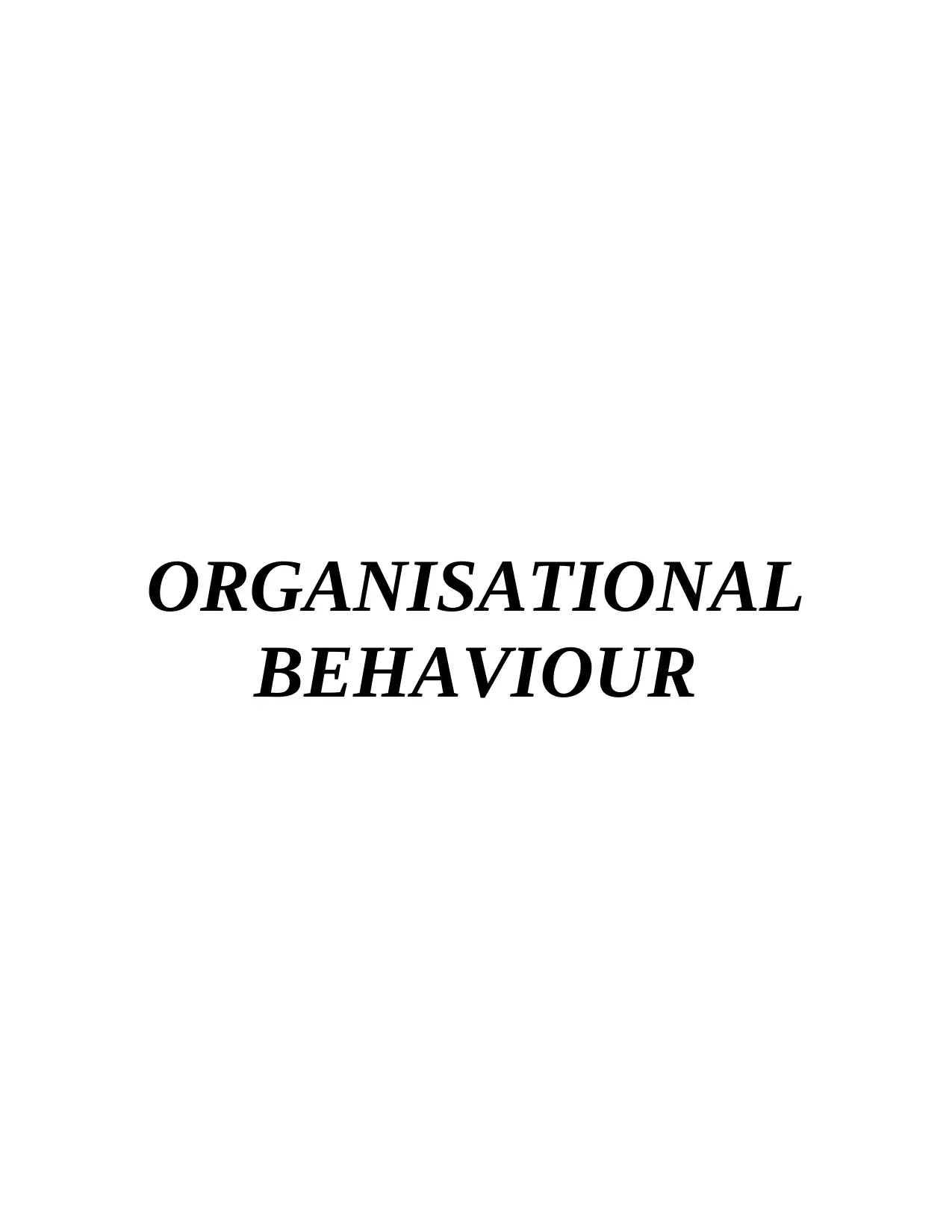
ORGANISATIONAL
BEHAVIOUR
BEHAVIOUR
Paraphrase This Document
Need a fresh take? Get an instant paraphrase of this document with our AI Paraphraser
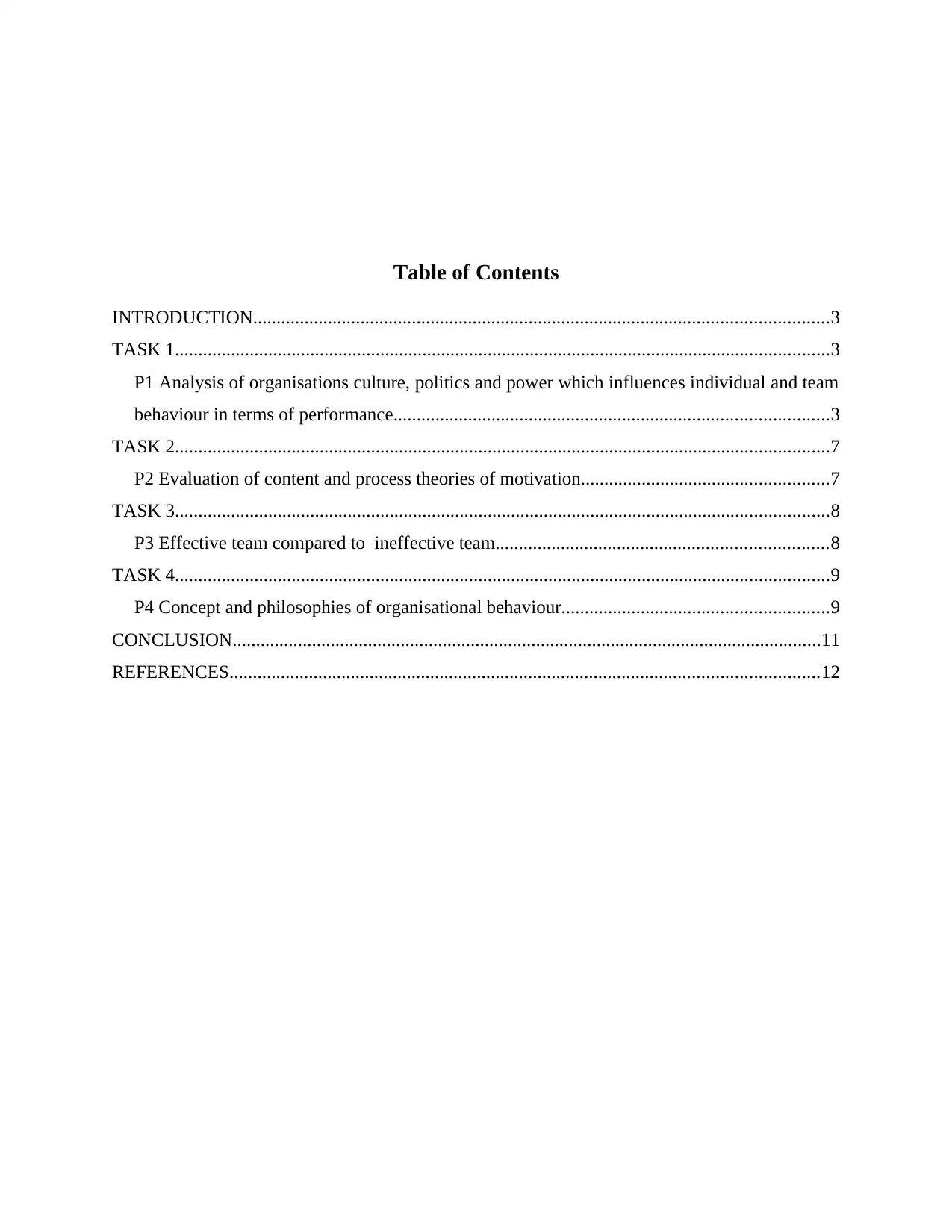
Table of Contents
INTRODUCTION...........................................................................................................................3
TASK 1............................................................................................................................................3
P1 Analysis of organisations culture, politics and power which influences individual and team
behaviour in terms of performance.............................................................................................3
TASK 2............................................................................................................................................7
P2 Evaluation of content and process theories of motivation.....................................................7
TASK 3............................................................................................................................................8
P3 Effective team compared to ineffective team.......................................................................8
TASK 4............................................................................................................................................9
P4 Concept and philosophies of organisational behaviour.........................................................9
CONCLUSION..............................................................................................................................11
REFERENCES..............................................................................................................................12
INTRODUCTION...........................................................................................................................3
TASK 1............................................................................................................................................3
P1 Analysis of organisations culture, politics and power which influences individual and team
behaviour in terms of performance.............................................................................................3
TASK 2............................................................................................................................................7
P2 Evaluation of content and process theories of motivation.....................................................7
TASK 3............................................................................................................................................8
P3 Effective team compared to ineffective team.......................................................................8
TASK 4............................................................................................................................................9
P4 Concept and philosophies of organisational behaviour.........................................................9
CONCLUSION..............................................................................................................................11
REFERENCES..............................................................................................................................12
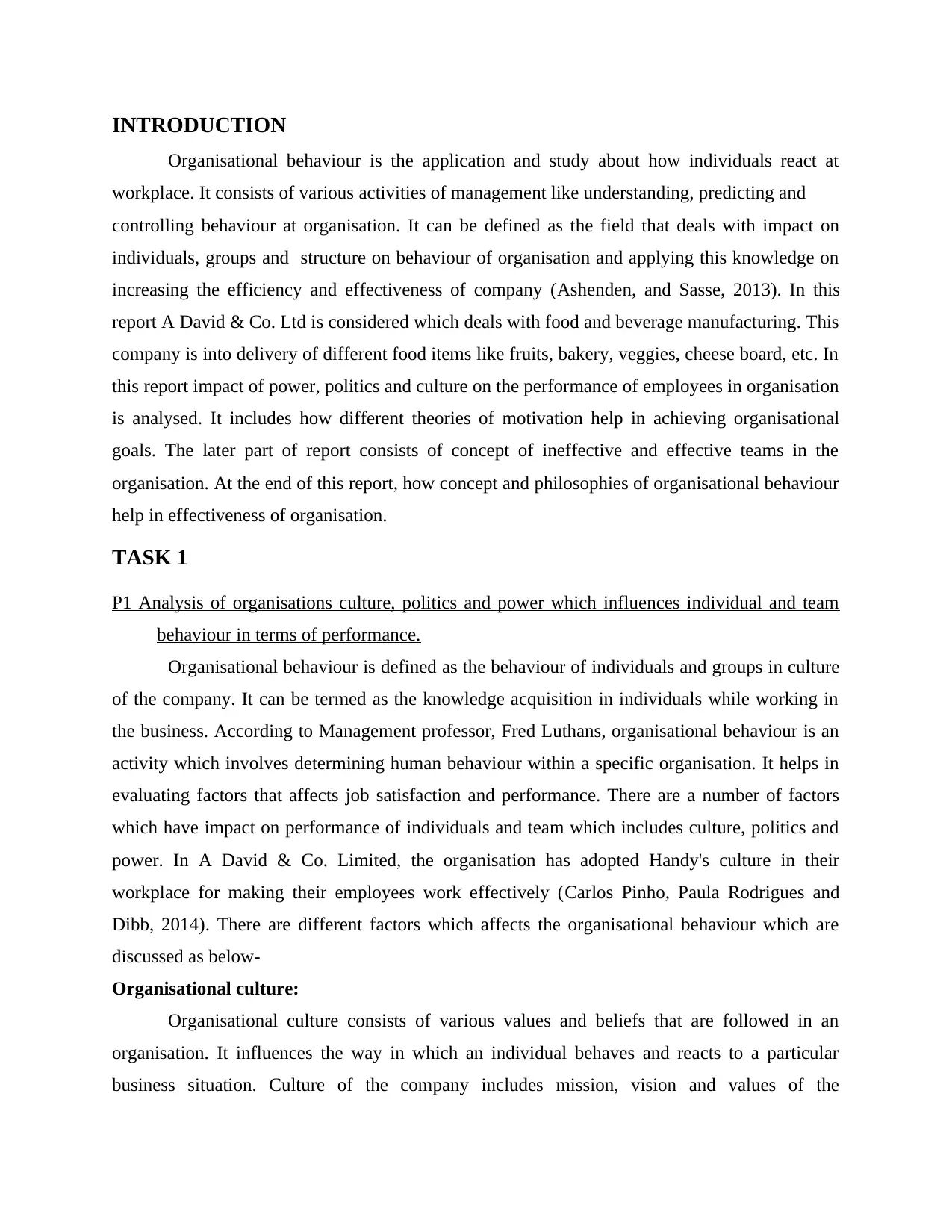
INTRODUCTION
Organisational behaviour is the application and study about how individuals react at
workplace. It consists of various activities of management like understanding, predicting and
controlling behaviour at organisation. It can be defined as the field that deals with impact on
individuals, groups and structure on behaviour of organisation and applying this knowledge on
increasing the efficiency and effectiveness of company (Ashenden, and Sasse, 2013). In this
report A David & Co. Ltd is considered which deals with food and beverage manufacturing. This
company is into delivery of different food items like fruits, bakery, veggies, cheese board, etc. In
this report impact of power, politics and culture on the performance of employees in organisation
is analysed. It includes how different theories of motivation help in achieving organisational
goals. The later part of report consists of concept of ineffective and effective teams in the
organisation. At the end of this report, how concept and philosophies of organisational behaviour
help in effectiveness of organisation.
TASK 1
P1 Analysis of organisations culture, politics and power which influences individual and team
behaviour in terms of performance.
Organisational behaviour is defined as the behaviour of individuals and groups in culture
of the company. It can be termed as the knowledge acquisition in individuals while working in
the business. According to Management professor, Fred Luthans, organisational behaviour is an
activity which involves determining human behaviour within a specific organisation. It helps in
evaluating factors that affects job satisfaction and performance. There are a number of factors
which have impact on performance of individuals and team which includes culture, politics and
power. In A David & Co. Limited, the organisation has adopted Handy's culture in their
workplace for making their employees work effectively (Carlos Pinho, Paula Rodrigues and
Dibb, 2014). There are different factors which affects the organisational behaviour which are
discussed as below-
Organisational culture:
Organisational culture consists of various values and beliefs that are followed in an
organisation. It influences the way in which an individual behaves and reacts to a particular
business situation. Culture of the company includes mission, vision and values of the
Organisational behaviour is the application and study about how individuals react at
workplace. It consists of various activities of management like understanding, predicting and
controlling behaviour at organisation. It can be defined as the field that deals with impact on
individuals, groups and structure on behaviour of organisation and applying this knowledge on
increasing the efficiency and effectiveness of company (Ashenden, and Sasse, 2013). In this
report A David & Co. Ltd is considered which deals with food and beverage manufacturing. This
company is into delivery of different food items like fruits, bakery, veggies, cheese board, etc. In
this report impact of power, politics and culture on the performance of employees in organisation
is analysed. It includes how different theories of motivation help in achieving organisational
goals. The later part of report consists of concept of ineffective and effective teams in the
organisation. At the end of this report, how concept and philosophies of organisational behaviour
help in effectiveness of organisation.
TASK 1
P1 Analysis of organisations culture, politics and power which influences individual and team
behaviour in terms of performance.
Organisational behaviour is defined as the behaviour of individuals and groups in culture
of the company. It can be termed as the knowledge acquisition in individuals while working in
the business. According to Management professor, Fred Luthans, organisational behaviour is an
activity which involves determining human behaviour within a specific organisation. It helps in
evaluating factors that affects job satisfaction and performance. There are a number of factors
which have impact on performance of individuals and team which includes culture, politics and
power. In A David & Co. Limited, the organisation has adopted Handy's culture in their
workplace for making their employees work effectively (Carlos Pinho, Paula Rodrigues and
Dibb, 2014). There are different factors which affects the organisational behaviour which are
discussed as below-
Organisational culture:
Organisational culture consists of various values and beliefs that are followed in an
organisation. It influences the way in which an individual behaves and reacts to a particular
business situation. Culture of the company includes mission, vision and values of the
⊘ This is a preview!⊘
Do you want full access?
Subscribe today to unlock all pages.

Trusted by 1+ million students worldwide
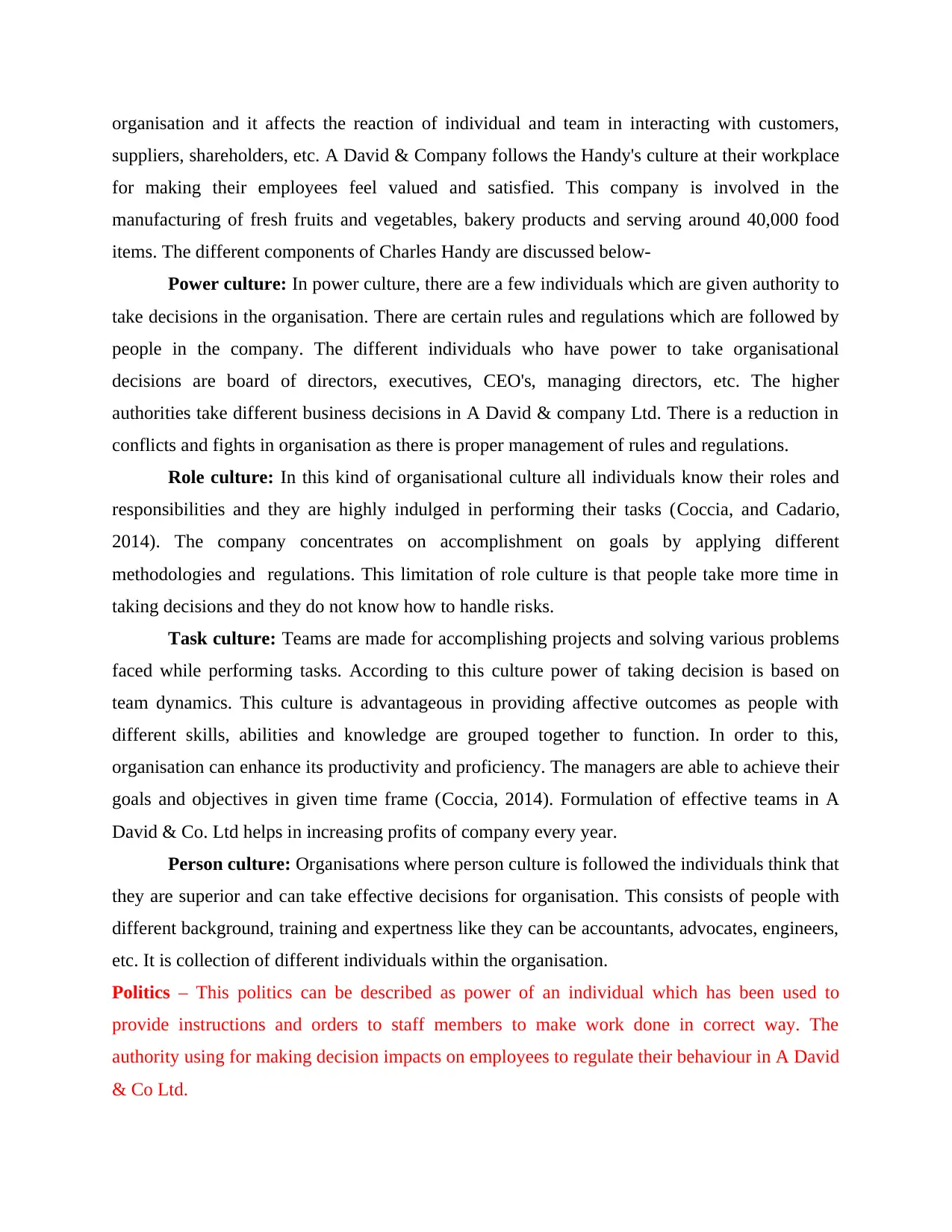
organisation and it affects the reaction of individual and team in interacting with customers,
suppliers, shareholders, etc. A David & Company follows the Handy's culture at their workplace
for making their employees feel valued and satisfied. This company is involved in the
manufacturing of fresh fruits and vegetables, bakery products and serving around 40,000 food
items. The different components of Charles Handy are discussed below-
Power culture: In power culture, there are a few individuals which are given authority to
take decisions in the organisation. There are certain rules and regulations which are followed by
people in the company. The different individuals who have power to take organisational
decisions are board of directors, executives, CEO's, managing directors, etc. The higher
authorities take different business decisions in A David & company Ltd. There is a reduction in
conflicts and fights in organisation as there is proper management of rules and regulations.
Role culture: In this kind of organisational culture all individuals know their roles and
responsibilities and they are highly indulged in performing their tasks (Coccia, and Cadario,
2014). The company concentrates on accomplishment on goals by applying different
methodologies and regulations. This limitation of role culture is that people take more time in
taking decisions and they do not know how to handle risks.
Task culture: Teams are made for accomplishing projects and solving various problems
faced while performing tasks. According to this culture power of taking decision is based on
team dynamics. This culture is advantageous in providing affective outcomes as people with
different skills, abilities and knowledge are grouped together to function. In order to this,
organisation can enhance its productivity and proficiency. The managers are able to achieve their
goals and objectives in given time frame (Coccia, 2014). Formulation of effective teams in A
David & Co. Ltd helps in increasing profits of company every year.
Person culture: Organisations where person culture is followed the individuals think that
they are superior and can take effective decisions for organisation. This consists of people with
different background, training and expertness like they can be accountants, advocates, engineers,
etc. It is collection of different individuals within the organisation.
Politics – This politics can be described as power of an individual which has been used to
provide instructions and orders to staff members to make work done in correct way. The
authority using for making decision impacts on employees to regulate their behaviour in A David
& Co Ltd.
suppliers, shareholders, etc. A David & Company follows the Handy's culture at their workplace
for making their employees feel valued and satisfied. This company is involved in the
manufacturing of fresh fruits and vegetables, bakery products and serving around 40,000 food
items. The different components of Charles Handy are discussed below-
Power culture: In power culture, there are a few individuals which are given authority to
take decisions in the organisation. There are certain rules and regulations which are followed by
people in the company. The different individuals who have power to take organisational
decisions are board of directors, executives, CEO's, managing directors, etc. The higher
authorities take different business decisions in A David & company Ltd. There is a reduction in
conflicts and fights in organisation as there is proper management of rules and regulations.
Role culture: In this kind of organisational culture all individuals know their roles and
responsibilities and they are highly indulged in performing their tasks (Coccia, and Cadario,
2014). The company concentrates on accomplishment on goals by applying different
methodologies and regulations. This limitation of role culture is that people take more time in
taking decisions and they do not know how to handle risks.
Task culture: Teams are made for accomplishing projects and solving various problems
faced while performing tasks. According to this culture power of taking decision is based on
team dynamics. This culture is advantageous in providing affective outcomes as people with
different skills, abilities and knowledge are grouped together to function. In order to this,
organisation can enhance its productivity and proficiency. The managers are able to achieve their
goals and objectives in given time frame (Coccia, 2014). Formulation of effective teams in A
David & Co. Ltd helps in increasing profits of company every year.
Person culture: Organisations where person culture is followed the individuals think that
they are superior and can take effective decisions for organisation. This consists of people with
different background, training and expertness like they can be accountants, advocates, engineers,
etc. It is collection of different individuals within the organisation.
Politics – This politics can be described as power of an individual which has been used to
provide instructions and orders to staff members to make work done in correct way. The
authority using for making decision impacts on employees to regulate their behaviour in A David
& Co Ltd.
Paraphrase This Document
Need a fresh take? Get an instant paraphrase of this document with our AI Paraphraser
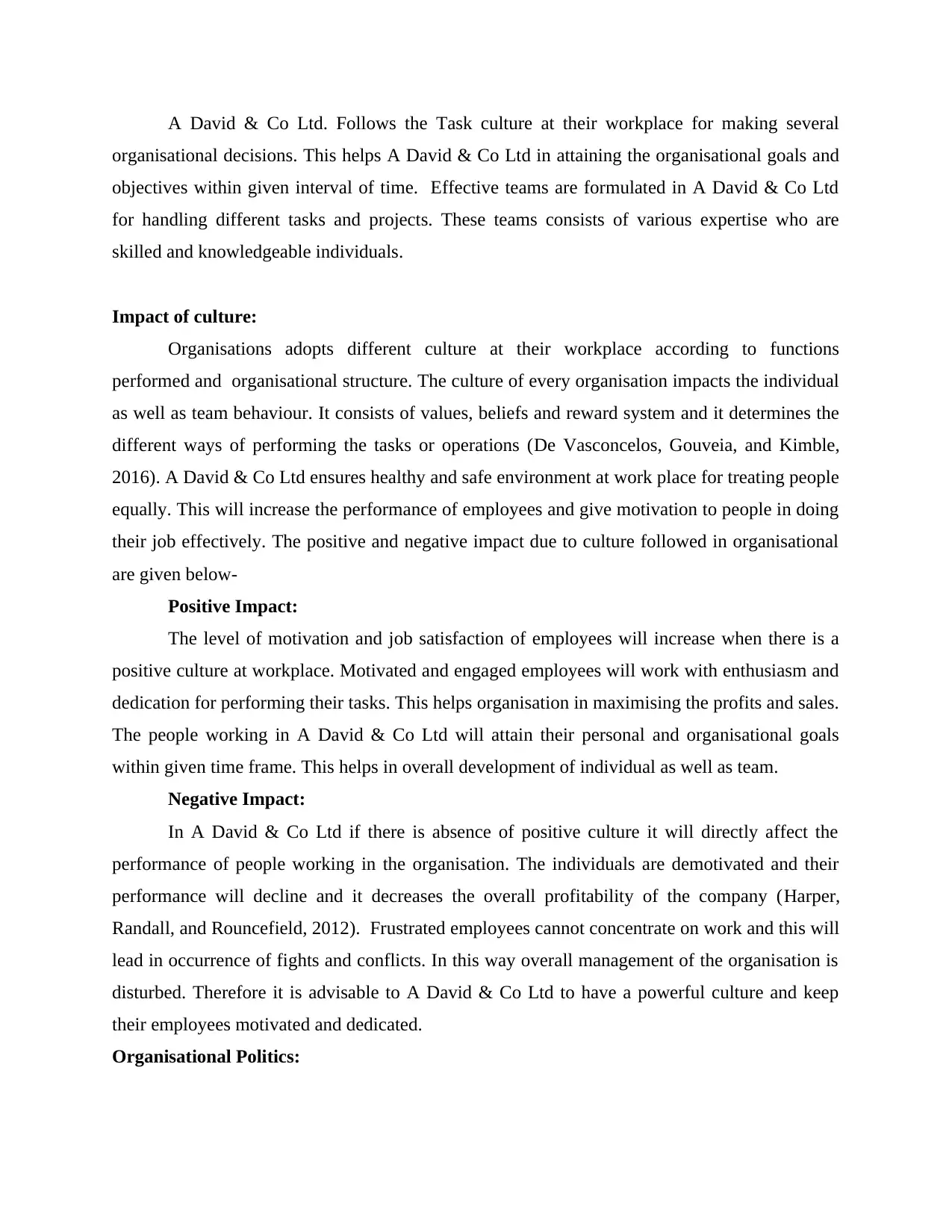
A David & Co Ltd. Follows the Task culture at their workplace for making several
organisational decisions. This helps A David & Co Ltd in attaining the organisational goals and
objectives within given interval of time. Effective teams are formulated in A David & Co Ltd
for handling different tasks and projects. These teams consists of various expertise who are
skilled and knowledgeable individuals.
Impact of culture:
Organisations adopts different culture at their workplace according to functions
performed and organisational structure. The culture of every organisation impacts the individual
as well as team behaviour. It consists of values, beliefs and reward system and it determines the
different ways of performing the tasks or operations (De Vasconcelos, Gouveia, and Kimble,
2016). A David & Co Ltd ensures healthy and safe environment at work place for treating people
equally. This will increase the performance of employees and give motivation to people in doing
their job effectively. The positive and negative impact due to culture followed in organisational
are given below-
Positive Impact:
The level of motivation and job satisfaction of employees will increase when there is a
positive culture at workplace. Motivated and engaged employees will work with enthusiasm and
dedication for performing their tasks. This helps organisation in maximising the profits and sales.
The people working in A David & Co Ltd will attain their personal and organisational goals
within given time frame. This helps in overall development of individual as well as team.
Negative Impact:
In A David & Co Ltd if there is absence of positive culture it will directly affect the
performance of people working in the organisation. The individuals are demotivated and their
performance will decline and it decreases the overall profitability of the company (Harper,
Randall, and Rouncefield, 2012). Frustrated employees cannot concentrate on work and this will
lead in occurrence of fights and conflicts. In this way overall management of the organisation is
disturbed. Therefore it is advisable to A David & Co Ltd to have a powerful culture and keep
their employees motivated and dedicated.
Organisational Politics:
organisational decisions. This helps A David & Co Ltd in attaining the organisational goals and
objectives within given interval of time. Effective teams are formulated in A David & Co Ltd
for handling different tasks and projects. These teams consists of various expertise who are
skilled and knowledgeable individuals.
Impact of culture:
Organisations adopts different culture at their workplace according to functions
performed and organisational structure. The culture of every organisation impacts the individual
as well as team behaviour. It consists of values, beliefs and reward system and it determines the
different ways of performing the tasks or operations (De Vasconcelos, Gouveia, and Kimble,
2016). A David & Co Ltd ensures healthy and safe environment at work place for treating people
equally. This will increase the performance of employees and give motivation to people in doing
their job effectively. The positive and negative impact due to culture followed in organisational
are given below-
Positive Impact:
The level of motivation and job satisfaction of employees will increase when there is a
positive culture at workplace. Motivated and engaged employees will work with enthusiasm and
dedication for performing their tasks. This helps organisation in maximising the profits and sales.
The people working in A David & Co Ltd will attain their personal and organisational goals
within given time frame. This helps in overall development of individual as well as team.
Negative Impact:
In A David & Co Ltd if there is absence of positive culture it will directly affect the
performance of people working in the organisation. The individuals are demotivated and their
performance will decline and it decreases the overall profitability of the company (Harper,
Randall, and Rouncefield, 2012). Frustrated employees cannot concentrate on work and this will
lead in occurrence of fights and conflicts. In this way overall management of the organisation is
disturbed. Therefore it is advisable to A David & Co Ltd to have a powerful culture and keep
their employees motivated and dedicated.
Organisational Politics:
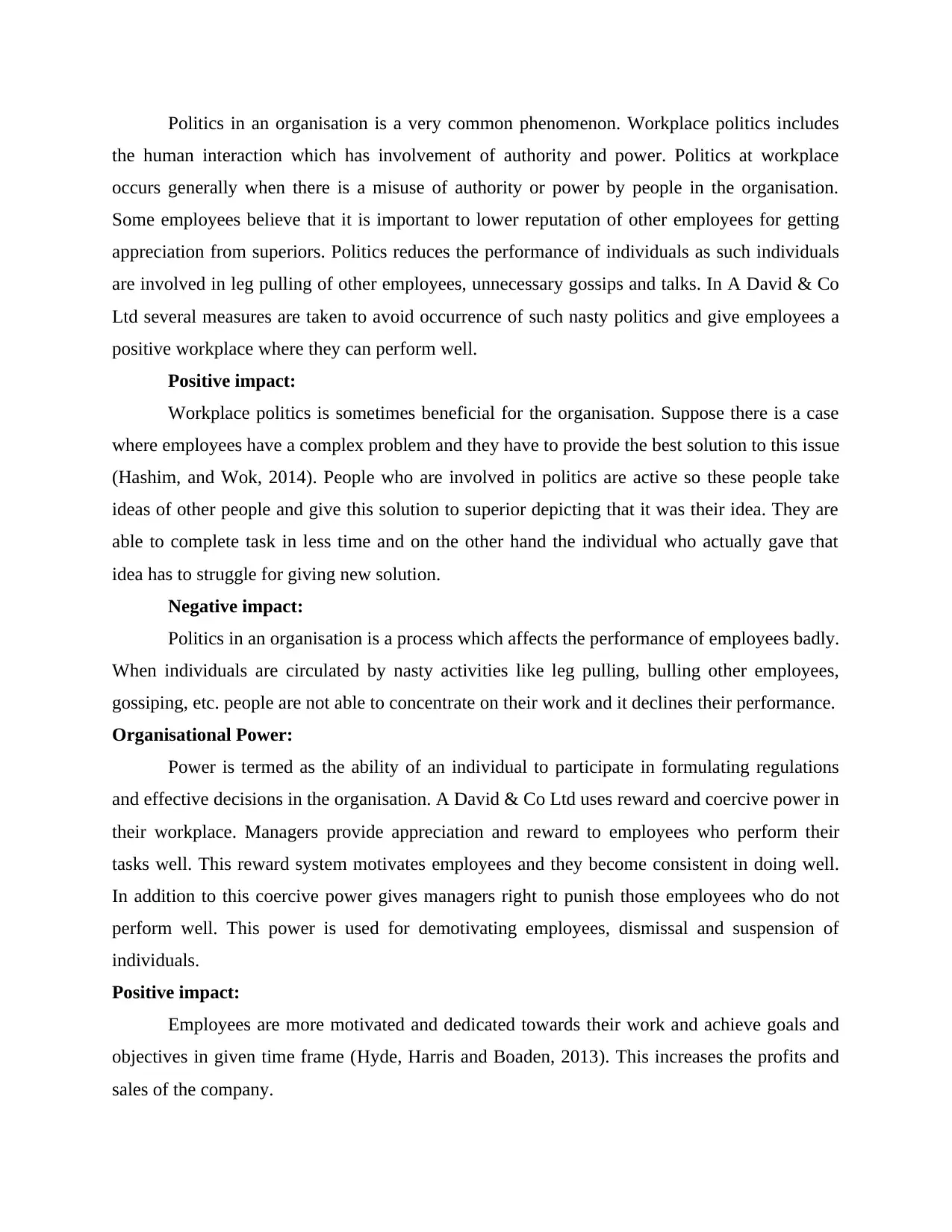
Politics in an organisation is a very common phenomenon. Workplace politics includes
the human interaction which has involvement of authority and power. Politics at workplace
occurs generally when there is a misuse of authority or power by people in the organisation.
Some employees believe that it is important to lower reputation of other employees for getting
appreciation from superiors. Politics reduces the performance of individuals as such individuals
are involved in leg pulling of other employees, unnecessary gossips and talks. In A David & Co
Ltd several measures are taken to avoid occurrence of such nasty politics and give employees a
positive workplace where they can perform well.
Positive impact:
Workplace politics is sometimes beneficial for the organisation. Suppose there is a case
where employees have a complex problem and they have to provide the best solution to this issue
(Hashim, and Wok, 2014). People who are involved in politics are active so these people take
ideas of other people and give this solution to superior depicting that it was their idea. They are
able to complete task in less time and on the other hand the individual who actually gave that
idea has to struggle for giving new solution.
Negative impact:
Politics in an organisation is a process which affects the performance of employees badly.
When individuals are circulated by nasty activities like leg pulling, bulling other employees,
gossiping, etc. people are not able to concentrate on their work and it declines their performance.
Organisational Power:
Power is termed as the ability of an individual to participate in formulating regulations
and effective decisions in the organisation. A David & Co Ltd uses reward and coercive power in
their workplace. Managers provide appreciation and reward to employees who perform their
tasks well. This reward system motivates employees and they become consistent in doing well.
In addition to this coercive power gives managers right to punish those employees who do not
perform well. This power is used for demotivating employees, dismissal and suspension of
individuals.
Positive impact:
Employees are more motivated and dedicated towards their work and achieve goals and
objectives in given time frame (Hyde, Harris and Boaden, 2013). This increases the profits and
sales of the company.
the human interaction which has involvement of authority and power. Politics at workplace
occurs generally when there is a misuse of authority or power by people in the organisation.
Some employees believe that it is important to lower reputation of other employees for getting
appreciation from superiors. Politics reduces the performance of individuals as such individuals
are involved in leg pulling of other employees, unnecessary gossips and talks. In A David & Co
Ltd several measures are taken to avoid occurrence of such nasty politics and give employees a
positive workplace where they can perform well.
Positive impact:
Workplace politics is sometimes beneficial for the organisation. Suppose there is a case
where employees have a complex problem and they have to provide the best solution to this issue
(Hashim, and Wok, 2014). People who are involved in politics are active so these people take
ideas of other people and give this solution to superior depicting that it was their idea. They are
able to complete task in less time and on the other hand the individual who actually gave that
idea has to struggle for giving new solution.
Negative impact:
Politics in an organisation is a process which affects the performance of employees badly.
When individuals are circulated by nasty activities like leg pulling, bulling other employees,
gossiping, etc. people are not able to concentrate on their work and it declines their performance.
Organisational Power:
Power is termed as the ability of an individual to participate in formulating regulations
and effective decisions in the organisation. A David & Co Ltd uses reward and coercive power in
their workplace. Managers provide appreciation and reward to employees who perform their
tasks well. This reward system motivates employees and they become consistent in doing well.
In addition to this coercive power gives managers right to punish those employees who do not
perform well. This power is used for demotivating employees, dismissal and suspension of
individuals.
Positive impact:
Employees are more motivated and dedicated towards their work and achieve goals and
objectives in given time frame (Hyde, Harris and Boaden, 2013). This increases the profits and
sales of the company.
⊘ This is a preview!⊘
Do you want full access?
Subscribe today to unlock all pages.

Trusted by 1+ million students worldwide
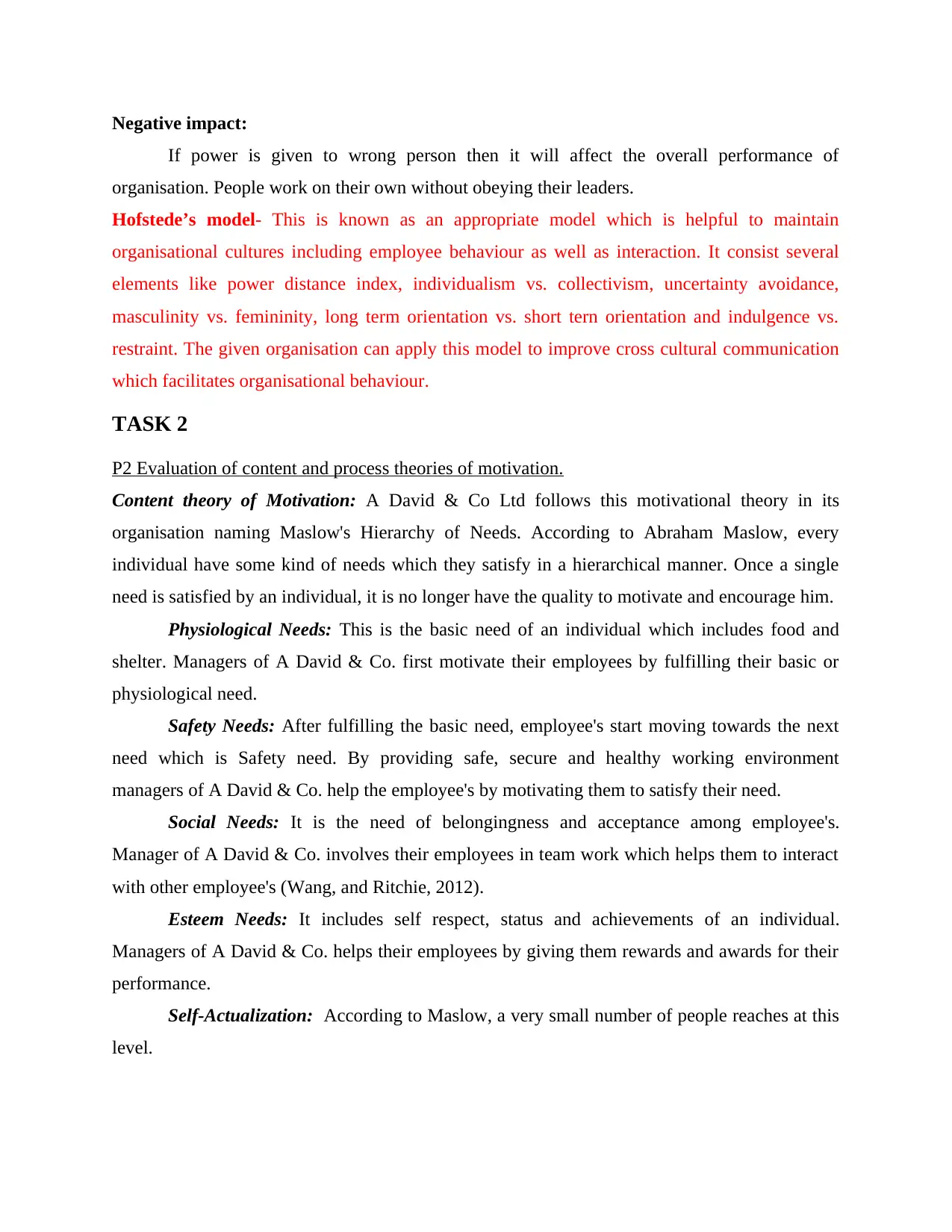
Negative impact:
If power is given to wrong person then it will affect the overall performance of
organisation. People work on their own without obeying their leaders.
Hofstede’s model- This is known as an appropriate model which is helpful to maintain
organisational cultures including employee behaviour as well as interaction. It consist several
elements like power distance index, individualism vs. collectivism, uncertainty avoidance,
masculinity vs. femininity, long term orientation vs. short tern orientation and indulgence vs.
restraint. The given organisation can apply this model to improve cross cultural communication
which facilitates organisational behaviour.
TASK 2
P2 Evaluation of content and process theories of motivation.
Content theory of Motivation: A David & Co Ltd follows this motivational theory in its
organisation naming Maslow's Hierarchy of Needs. According to Abraham Maslow, every
individual have some kind of needs which they satisfy in a hierarchical manner. Once a single
need is satisfied by an individual, it is no longer have the quality to motivate and encourage him.
Physiological Needs: This is the basic need of an individual which includes food and
shelter. Managers of A David & Co. first motivate their employees by fulfilling their basic or
physiological need.
Safety Needs: After fulfilling the basic need, employee's start moving towards the next
need which is Safety need. By providing safe, secure and healthy working environment
managers of A David & Co. help the employee's by motivating them to satisfy their need.
Social Needs: It is the need of belongingness and acceptance among employee's.
Manager of A David & Co. involves their employees in team work which helps them to interact
with other employee's (Wang, and Ritchie, 2012).
Esteem Needs: It includes self respect, status and achievements of an individual.
Managers of A David & Co. helps their employees by giving them rewards and awards for their
performance.
Self-Actualization: According to Maslow, a very small number of people reaches at this
level.
If power is given to wrong person then it will affect the overall performance of
organisation. People work on their own without obeying their leaders.
Hofstede’s model- This is known as an appropriate model which is helpful to maintain
organisational cultures including employee behaviour as well as interaction. It consist several
elements like power distance index, individualism vs. collectivism, uncertainty avoidance,
masculinity vs. femininity, long term orientation vs. short tern orientation and indulgence vs.
restraint. The given organisation can apply this model to improve cross cultural communication
which facilitates organisational behaviour.
TASK 2
P2 Evaluation of content and process theories of motivation.
Content theory of Motivation: A David & Co Ltd follows this motivational theory in its
organisation naming Maslow's Hierarchy of Needs. According to Abraham Maslow, every
individual have some kind of needs which they satisfy in a hierarchical manner. Once a single
need is satisfied by an individual, it is no longer have the quality to motivate and encourage him.
Physiological Needs: This is the basic need of an individual which includes food and
shelter. Managers of A David & Co. first motivate their employees by fulfilling their basic or
physiological need.
Safety Needs: After fulfilling the basic need, employee's start moving towards the next
need which is Safety need. By providing safe, secure and healthy working environment
managers of A David & Co. help the employee's by motivating them to satisfy their need.
Social Needs: It is the need of belongingness and acceptance among employee's.
Manager of A David & Co. involves their employees in team work which helps them to interact
with other employee's (Wang, and Ritchie, 2012).
Esteem Needs: It includes self respect, status and achievements of an individual.
Managers of A David & Co. helps their employees by giving them rewards and awards for their
performance.
Self-Actualization: According to Maslow, a very small number of people reaches at this
level.
Paraphrase This Document
Need a fresh take? Get an instant paraphrase of this document with our AI Paraphraser
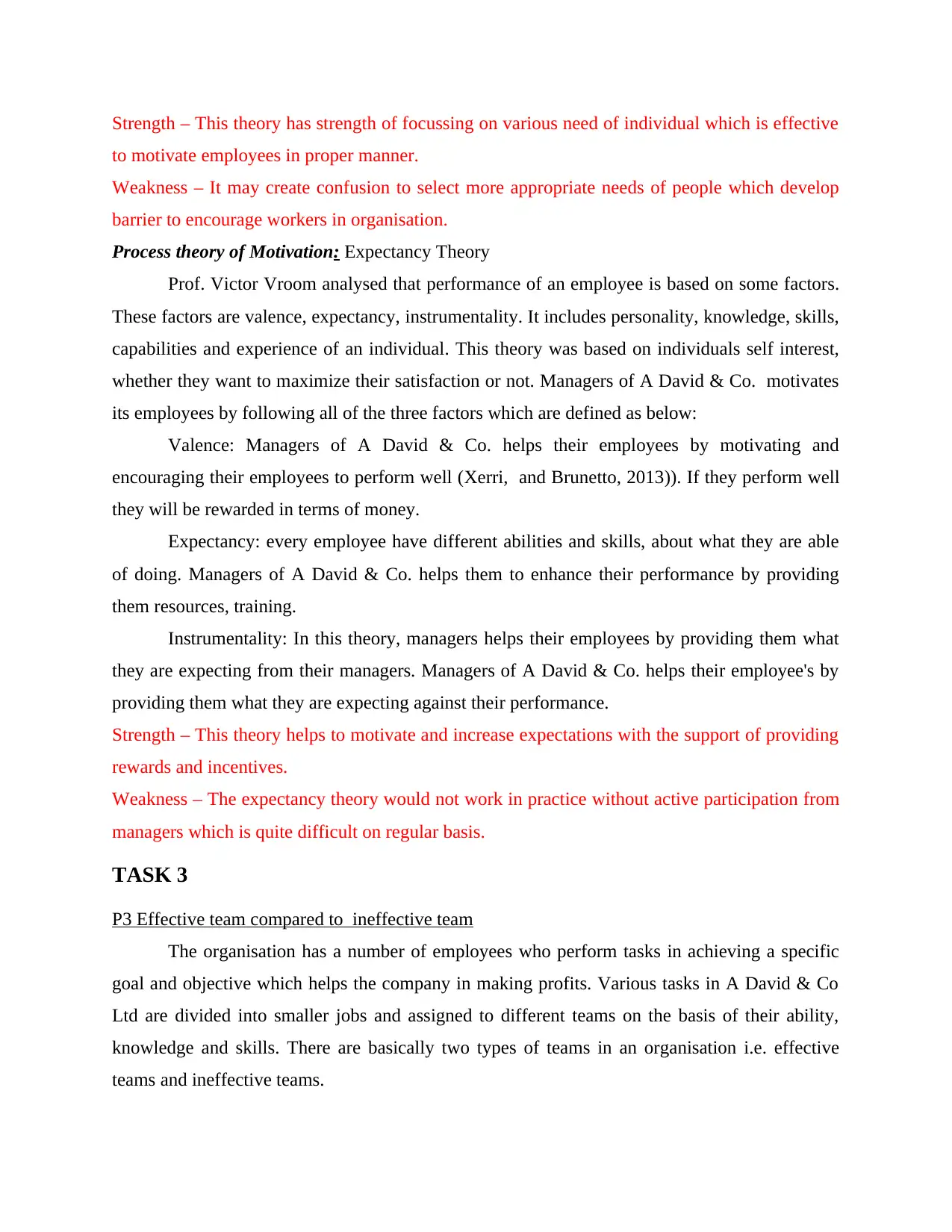
Strength – This theory has strength of focussing on various need of individual which is effective
to motivate employees in proper manner.
Weakness – It may create confusion to select more appropriate needs of people which develop
barrier to encourage workers in organisation.
Process theory of Motivation: Expectancy Theory
Prof. Victor Vroom analysed that performance of an employee is based on some factors.
These factors are valence, expectancy, instrumentality. It includes personality, knowledge, skills,
capabilities and experience of an individual. This theory was based on individuals self interest,
whether they want to maximize their satisfaction or not. Managers of A David & Co. motivates
its employees by following all of the three factors which are defined as below:
Valence: Managers of A David & Co. helps their employees by motivating and
encouraging their employees to perform well (Xerri, and Brunetto, 2013)). If they perform well
they will be rewarded in terms of money.
Expectancy: every employee have different abilities and skills, about what they are able
of doing. Managers of A David & Co. helps them to enhance their performance by providing
them resources, training.
Instrumentality: In this theory, managers helps their employees by providing them what
they are expecting from their managers. Managers of A David & Co. helps their employee's by
providing them what they are expecting against their performance.
Strength – This theory helps to motivate and increase expectations with the support of providing
rewards and incentives.
Weakness – The expectancy theory would not work in practice without active participation from
managers which is quite difficult on regular basis.
TASK 3
P3 Effective team compared to ineffective team
The organisation has a number of employees who perform tasks in achieving a specific
goal and objective which helps the company in making profits. Various tasks in A David & Co
Ltd are divided into smaller jobs and assigned to different teams on the basis of their ability,
knowledge and skills. There are basically two types of teams in an organisation i.e. effective
teams and ineffective teams.
to motivate employees in proper manner.
Weakness – It may create confusion to select more appropriate needs of people which develop
barrier to encourage workers in organisation.
Process theory of Motivation: Expectancy Theory
Prof. Victor Vroom analysed that performance of an employee is based on some factors.
These factors are valence, expectancy, instrumentality. It includes personality, knowledge, skills,
capabilities and experience of an individual. This theory was based on individuals self interest,
whether they want to maximize their satisfaction or not. Managers of A David & Co. motivates
its employees by following all of the three factors which are defined as below:
Valence: Managers of A David & Co. helps their employees by motivating and
encouraging their employees to perform well (Xerri, and Brunetto, 2013)). If they perform well
they will be rewarded in terms of money.
Expectancy: every employee have different abilities and skills, about what they are able
of doing. Managers of A David & Co. helps them to enhance their performance by providing
them resources, training.
Instrumentality: In this theory, managers helps their employees by providing them what
they are expecting from their managers. Managers of A David & Co. helps their employee's by
providing them what they are expecting against their performance.
Strength – This theory helps to motivate and increase expectations with the support of providing
rewards and incentives.
Weakness – The expectancy theory would not work in practice without active participation from
managers which is quite difficult on regular basis.
TASK 3
P3 Effective team compared to ineffective team
The organisation has a number of employees who perform tasks in achieving a specific
goal and objective which helps the company in making profits. Various tasks in A David & Co
Ltd are divided into smaller jobs and assigned to different teams on the basis of their ability,
knowledge and skills. There are basically two types of teams in an organisation i.e. effective
teams and ineffective teams.
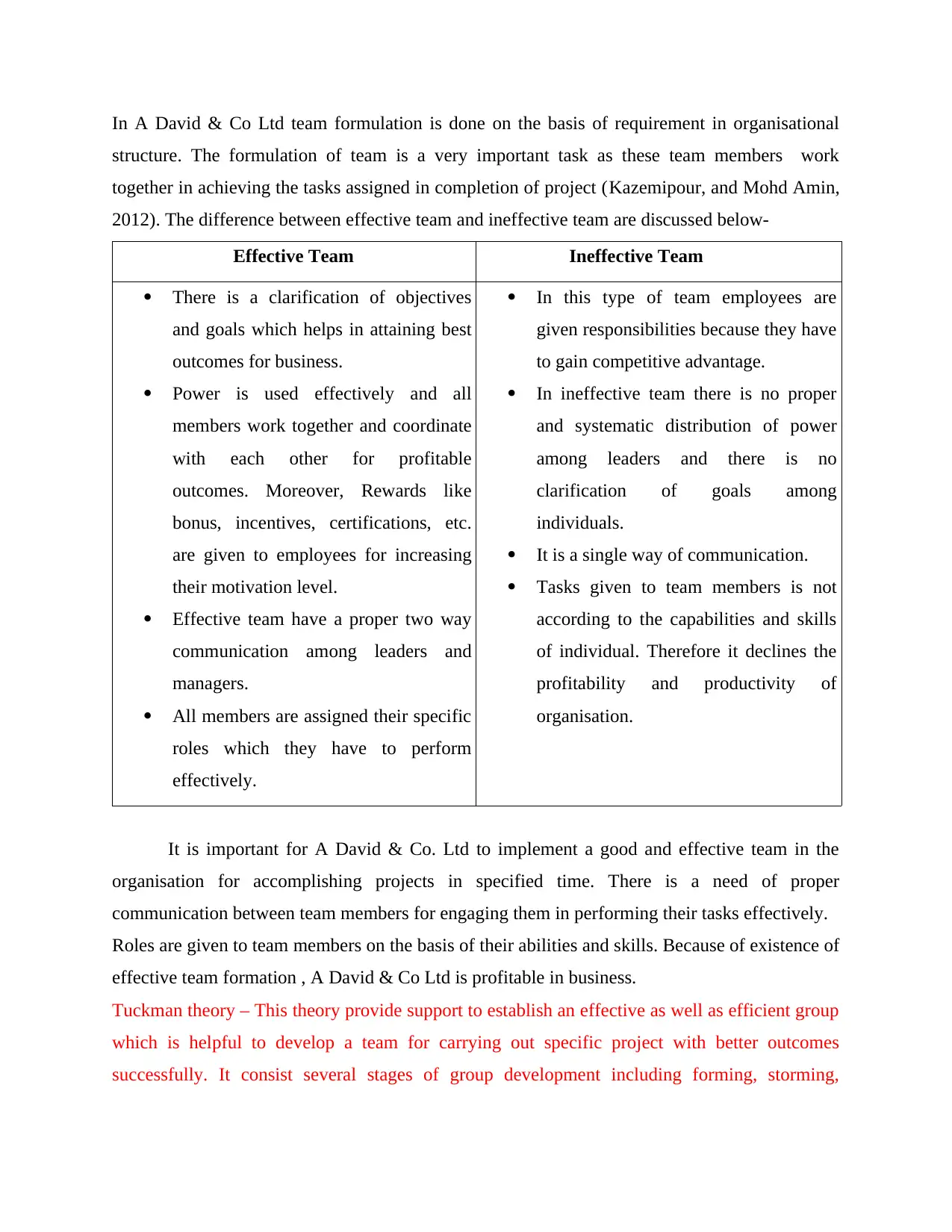
In A David & Co Ltd team formulation is done on the basis of requirement in organisational
structure. The formulation of team is a very important task as these team members work
together in achieving the tasks assigned in completion of project (Kazemipour, and Mohd Amin,
2012). The difference between effective team and ineffective team are discussed below-
Effective Team Ineffective Team
There is a clarification of objectives
and goals which helps in attaining best
outcomes for business.
Power is used effectively and all
members work together and coordinate
with each other for profitable
outcomes. Moreover, Rewards like
bonus, incentives, certifications, etc.
are given to employees for increasing
their motivation level.
Effective team have a proper two way
communication among leaders and
managers.
All members are assigned their specific
roles which they have to perform
effectively.
In this type of team employees are
given responsibilities because they have
to gain competitive advantage.
In ineffective team there is no proper
and systematic distribution of power
among leaders and there is no
clarification of goals among
individuals.
It is a single way of communication.
Tasks given to team members is not
according to the capabilities and skills
of individual. Therefore it declines the
profitability and productivity of
organisation.
It is important for A David & Co. Ltd to implement a good and effective team in the
organisation for accomplishing projects in specified time. There is a need of proper
communication between team members for engaging them in performing their tasks effectively.
Roles are given to team members on the basis of their abilities and skills. Because of existence of
effective team formation , A David & Co Ltd is profitable in business.
Tuckman theory – This theory provide support to establish an effective as well as efficient group
which is helpful to develop a team for carrying out specific project with better outcomes
successfully. It consist several stages of group development including forming, storming,
structure. The formulation of team is a very important task as these team members work
together in achieving the tasks assigned in completion of project (Kazemipour, and Mohd Amin,
2012). The difference between effective team and ineffective team are discussed below-
Effective Team Ineffective Team
There is a clarification of objectives
and goals which helps in attaining best
outcomes for business.
Power is used effectively and all
members work together and coordinate
with each other for profitable
outcomes. Moreover, Rewards like
bonus, incentives, certifications, etc.
are given to employees for increasing
their motivation level.
Effective team have a proper two way
communication among leaders and
managers.
All members are assigned their specific
roles which they have to perform
effectively.
In this type of team employees are
given responsibilities because they have
to gain competitive advantage.
In ineffective team there is no proper
and systematic distribution of power
among leaders and there is no
clarification of goals among
individuals.
It is a single way of communication.
Tasks given to team members is not
according to the capabilities and skills
of individual. Therefore it declines the
profitability and productivity of
organisation.
It is important for A David & Co. Ltd to implement a good and effective team in the
organisation for accomplishing projects in specified time. There is a need of proper
communication between team members for engaging them in performing their tasks effectively.
Roles are given to team members on the basis of their abilities and skills. Because of existence of
effective team formation , A David & Co Ltd is profitable in business.
Tuckman theory – This theory provide support to establish an effective as well as efficient group
which is helpful to develop a team for carrying out specific project with better outcomes
successfully. It consist several stages of group development including forming, storming,
⊘ This is a preview!⊘
Do you want full access?
Subscribe today to unlock all pages.

Trusted by 1+ million students worldwide
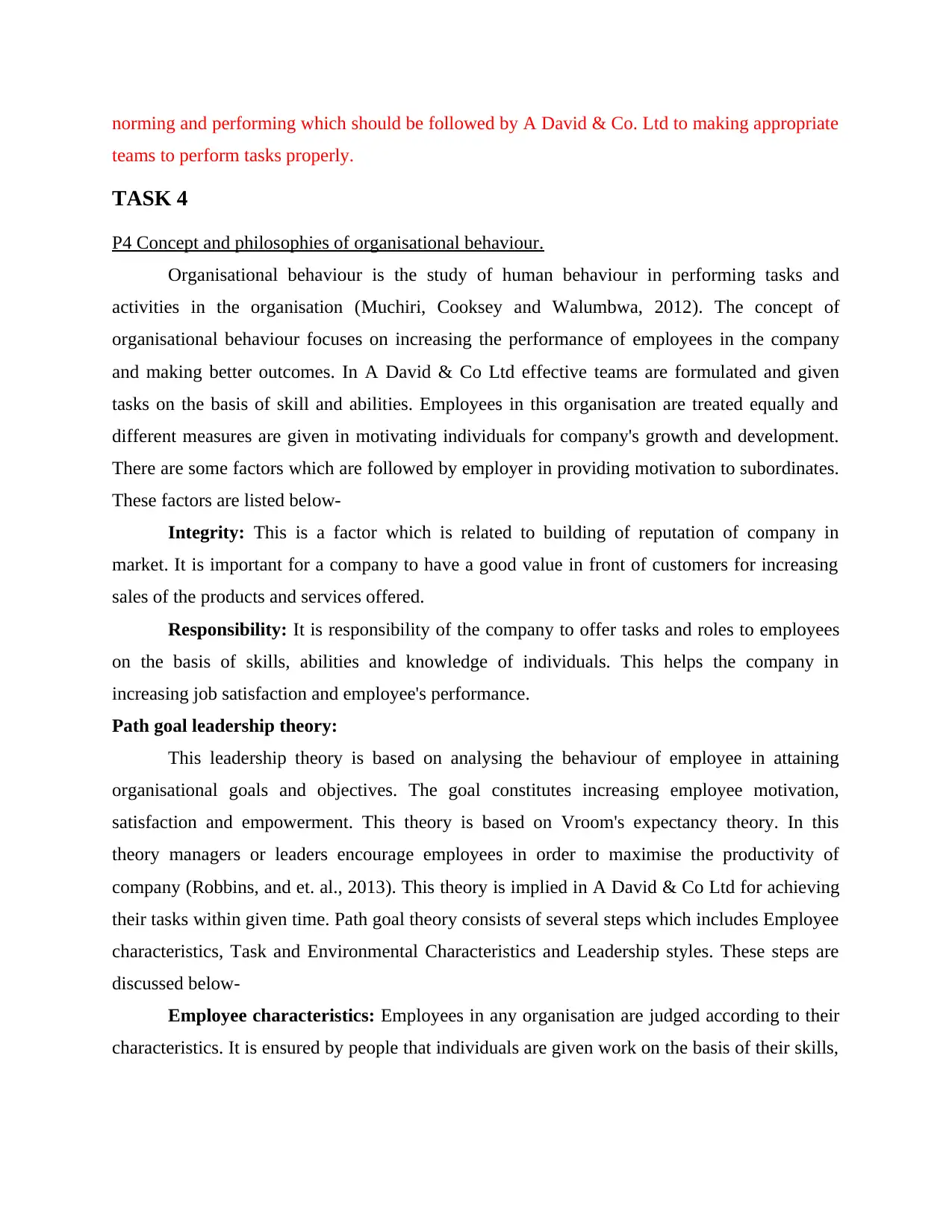
norming and performing which should be followed by A David & Co. Ltd to making appropriate
teams to perform tasks properly.
TASK 4
P4 Concept and philosophies of organisational behaviour.
Organisational behaviour is the study of human behaviour in performing tasks and
activities in the organisation (Muchiri, Cooksey and Walumbwa, 2012). The concept of
organisational behaviour focuses on increasing the performance of employees in the company
and making better outcomes. In A David & Co Ltd effective teams are formulated and given
tasks on the basis of skill and abilities. Employees in this organisation are treated equally and
different measures are given in motivating individuals for company's growth and development.
There are some factors which are followed by employer in providing motivation to subordinates.
These factors are listed below-
Integrity: This is a factor which is related to building of reputation of company in
market. It is important for a company to have a good value in front of customers for increasing
sales of the products and services offered.
Responsibility: It is responsibility of the company to offer tasks and roles to employees
on the basis of skills, abilities and knowledge of individuals. This helps the company in
increasing job satisfaction and employee's performance.
Path goal leadership theory:
This leadership theory is based on analysing the behaviour of employee in attaining
organisational goals and objectives. The goal constitutes increasing employee motivation,
satisfaction and empowerment. This theory is based on Vroom's expectancy theory. In this
theory managers or leaders encourage employees in order to maximise the productivity of
company (Robbins, and et. al., 2013). This theory is implied in A David & Co Ltd for achieving
their tasks within given time. Path goal theory consists of several steps which includes Employee
characteristics, Task and Environmental Characteristics and Leadership styles. These steps are
discussed below-
Employee characteristics: Employees in any organisation are judged according to their
characteristics. It is ensured by people that individuals are given work on the basis of their skills,
teams to perform tasks properly.
TASK 4
P4 Concept and philosophies of organisational behaviour.
Organisational behaviour is the study of human behaviour in performing tasks and
activities in the organisation (Muchiri, Cooksey and Walumbwa, 2012). The concept of
organisational behaviour focuses on increasing the performance of employees in the company
and making better outcomes. In A David & Co Ltd effective teams are formulated and given
tasks on the basis of skill and abilities. Employees in this organisation are treated equally and
different measures are given in motivating individuals for company's growth and development.
There are some factors which are followed by employer in providing motivation to subordinates.
These factors are listed below-
Integrity: This is a factor which is related to building of reputation of company in
market. It is important for a company to have a good value in front of customers for increasing
sales of the products and services offered.
Responsibility: It is responsibility of the company to offer tasks and roles to employees
on the basis of skills, abilities and knowledge of individuals. This helps the company in
increasing job satisfaction and employee's performance.
Path goal leadership theory:
This leadership theory is based on analysing the behaviour of employee in attaining
organisational goals and objectives. The goal constitutes increasing employee motivation,
satisfaction and empowerment. This theory is based on Vroom's expectancy theory. In this
theory managers or leaders encourage employees in order to maximise the productivity of
company (Robbins, and et. al., 2013). This theory is implied in A David & Co Ltd for achieving
their tasks within given time. Path goal theory consists of several steps which includes Employee
characteristics, Task and Environmental Characteristics and Leadership styles. These steps are
discussed below-
Employee characteristics: Employees in any organisation are judged according to their
characteristics. It is ensured by people that individuals are given work on the basis of their skills,
Paraphrase This Document
Need a fresh take? Get an instant paraphrase of this document with our AI Paraphraser
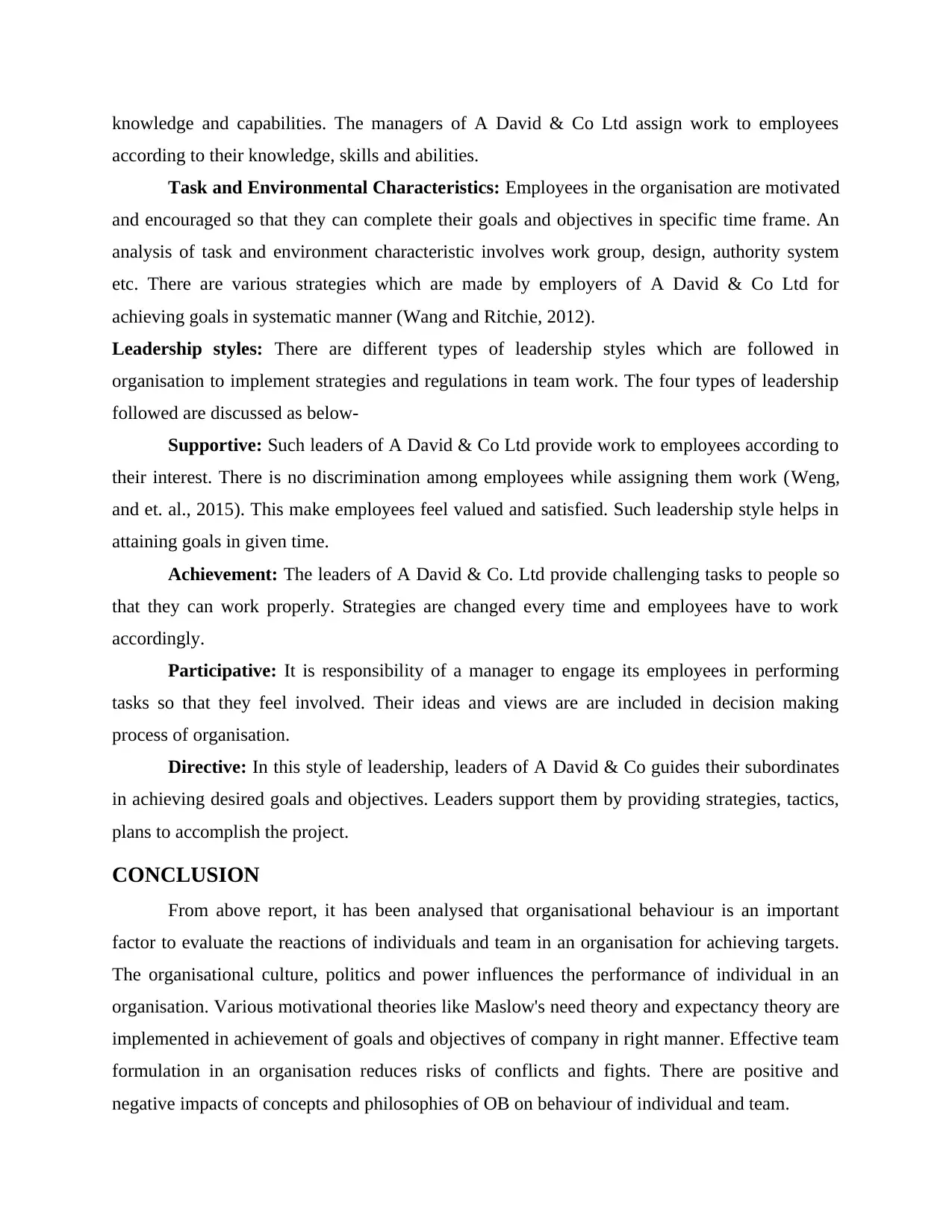
knowledge and capabilities. The managers of A David & Co Ltd assign work to employees
according to their knowledge, skills and abilities.
Task and Environmental Characteristics: Employees in the organisation are motivated
and encouraged so that they can complete their goals and objectives in specific time frame. An
analysis of task and environment characteristic involves work group, design, authority system
etc. There are various strategies which are made by employers of A David & Co Ltd for
achieving goals in systematic manner (Wang and Ritchie, 2012).
Leadership styles: There are different types of leadership styles which are followed in
organisation to implement strategies and regulations in team work. The four types of leadership
followed are discussed as below-
Supportive: Such leaders of A David & Co Ltd provide work to employees according to
their interest. There is no discrimination among employees while assigning them work (Weng,
and et. al., 2015). This make employees feel valued and satisfied. Such leadership style helps in
attaining goals in given time.
Achievement: The leaders of A David & Co. Ltd provide challenging tasks to people so
that they can work properly. Strategies are changed every time and employees have to work
accordingly.
Participative: It is responsibility of a manager to engage its employees in performing
tasks so that they feel involved. Their ideas and views are are included in decision making
process of organisation.
Directive: In this style of leadership, leaders of A David & Co guides their subordinates
in achieving desired goals and objectives. Leaders support them by providing strategies, tactics,
plans to accomplish the project.
CONCLUSION
From above report, it has been analysed that organisational behaviour is an important
factor to evaluate the reactions of individuals and team in an organisation for achieving targets.
The organisational culture, politics and power influences the performance of individual in an
organisation. Various motivational theories like Maslow's need theory and expectancy theory are
implemented in achievement of goals and objectives of company in right manner. Effective team
formulation in an organisation reduces risks of conflicts and fights. There are positive and
negative impacts of concepts and philosophies of OB on behaviour of individual and team.
according to their knowledge, skills and abilities.
Task and Environmental Characteristics: Employees in the organisation are motivated
and encouraged so that they can complete their goals and objectives in specific time frame. An
analysis of task and environment characteristic involves work group, design, authority system
etc. There are various strategies which are made by employers of A David & Co Ltd for
achieving goals in systematic manner (Wang and Ritchie, 2012).
Leadership styles: There are different types of leadership styles which are followed in
organisation to implement strategies and regulations in team work. The four types of leadership
followed are discussed as below-
Supportive: Such leaders of A David & Co Ltd provide work to employees according to
their interest. There is no discrimination among employees while assigning them work (Weng,
and et. al., 2015). This make employees feel valued and satisfied. Such leadership style helps in
attaining goals in given time.
Achievement: The leaders of A David & Co. Ltd provide challenging tasks to people so
that they can work properly. Strategies are changed every time and employees have to work
accordingly.
Participative: It is responsibility of a manager to engage its employees in performing
tasks so that they feel involved. Their ideas and views are are included in decision making
process of organisation.
Directive: In this style of leadership, leaders of A David & Co guides their subordinates
in achieving desired goals and objectives. Leaders support them by providing strategies, tactics,
plans to accomplish the project.
CONCLUSION
From above report, it has been analysed that organisational behaviour is an important
factor to evaluate the reactions of individuals and team in an organisation for achieving targets.
The organisational culture, politics and power influences the performance of individual in an
organisation. Various motivational theories like Maslow's need theory and expectancy theory are
implemented in achievement of goals and objectives of company in right manner. Effective team
formulation in an organisation reduces risks of conflicts and fights. There are positive and
negative impacts of concepts and philosophies of OB on behaviour of individual and team.
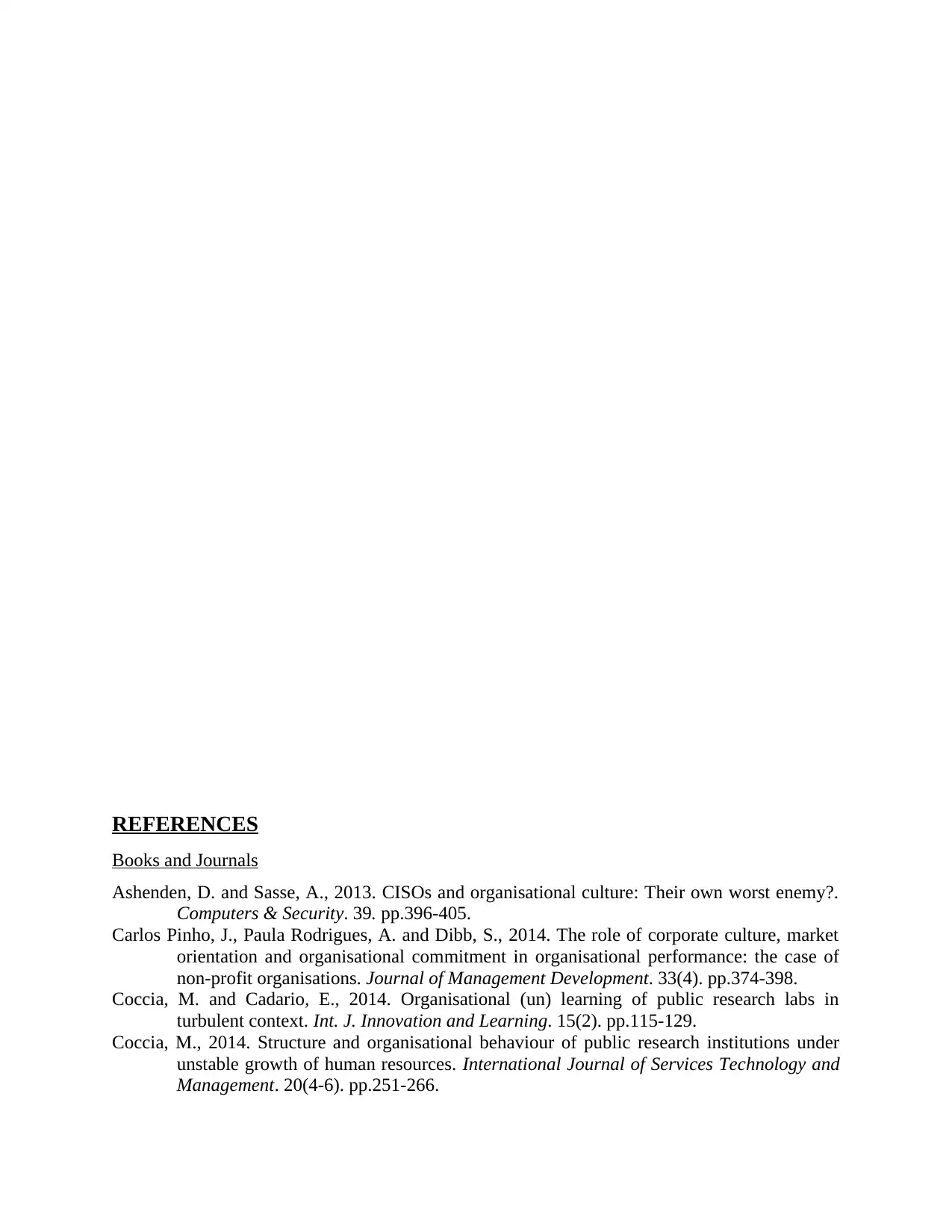
REFERENCES
Books and Journals
Ashenden, D. and Sasse, A., 2013. CISOs and organisational culture: Their own worst enemy?.
Computers & Security. 39. pp.396-405.
Carlos Pinho, J., Paula Rodrigues, A. and Dibb, S., 2014. The role of corporate culture, market
orientation and organisational commitment in organisational performance: the case of
non-profit organisations. Journal of Management Development. 33(4). pp.374-398.
Coccia, M. and Cadario, E., 2014. Organisational (un) learning of public research labs in
turbulent context. Int. J. Innovation and Learning. 15(2). pp.115-129.
Coccia, M., 2014. Structure and organisational behaviour of public research institutions under
unstable growth of human resources. International Journal of Services Technology and
Management. 20(4-6). pp.251-266.
Books and Journals
Ashenden, D. and Sasse, A., 2013. CISOs and organisational culture: Their own worst enemy?.
Computers & Security. 39. pp.396-405.
Carlos Pinho, J., Paula Rodrigues, A. and Dibb, S., 2014. The role of corporate culture, market
orientation and organisational commitment in organisational performance: the case of
non-profit organisations. Journal of Management Development. 33(4). pp.374-398.
Coccia, M. and Cadario, E., 2014. Organisational (un) learning of public research labs in
turbulent context. Int. J. Innovation and Learning. 15(2). pp.115-129.
Coccia, M., 2014. Structure and organisational behaviour of public research institutions under
unstable growth of human resources. International Journal of Services Technology and
Management. 20(4-6). pp.251-266.
⊘ This is a preview!⊘
Do you want full access?
Subscribe today to unlock all pages.

Trusted by 1+ million students worldwide
1 out of 13
Related Documents
Your All-in-One AI-Powered Toolkit for Academic Success.
+13062052269
info@desklib.com
Available 24*7 on WhatsApp / Email
![[object Object]](/_next/static/media/star-bottom.7253800d.svg)
Unlock your academic potential
Copyright © 2020–2025 A2Z Services. All Rights Reserved. Developed and managed by ZUCOL.





